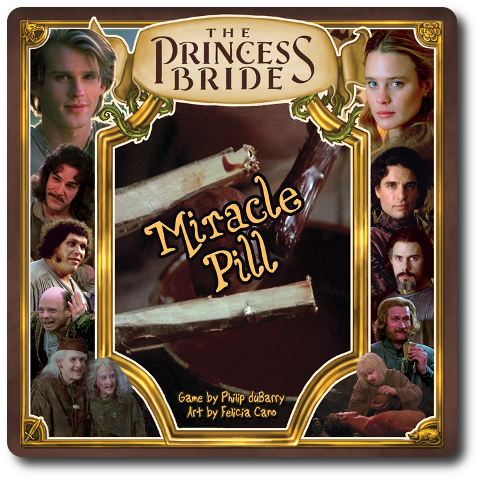
The Basics:
- For ages 8 and up (publisher suggests 10+)
- For 2 to 6 players
- Approximately 15 minutes to complete
Geek Skills:
- Counting & Math
- Logical & Critical Decision Making
- Reading
- Pattern/Color Matching
- Strategy & Tactics
- Risk vs. Reward
- Hand/Resource Management
Learning Curve:
- Child – Easy
- Adult – Easy
Theme & Narrative:
- You really can make miracles come true (if you have the right stuff)
Endorsements:
- Gamer Geek rejected!
- Parent Geek approved!
- Child Geek approved!
Overview
American actor, writer, director, and producer, Michael Landon, said “I think all of us create our own miracles.” In this game, Mr. Landon is absolutely correct. By collecting the right number and type of cards, miracles can be created. But be careful, as miracles can be sabotaged, as well!
The Princess Bride: Miracle Pill, designed by Philip duBarry and published by Game Salute, is comprised of 72 Ingredient cards that depict a wide range of possible additives that are included in Miracle Max’s Miracle Pill. The cards are as thick and as durable as your standard playing card. The artwork by Felicia Cano is stylized and fits the game’s theme, while at the same time clearly communicating to the card holder all the information they need to know.
Note: You need not be familiar with the film The Princess Bride to play this game. Those who have not seen the film, however, will wonder what a Miracle Pill is. In the movie, a character by the name of Miracle Max creates a pill that heals one of the main protagonists, named The Man in Black, who is “mostly” dead.
Game Set Up
To set up the game, first separate the cards into 3 decks by using the back of the cards. A number value is listed there that identifies which round the cards will be played in. When completed, there will be 3 decks of 24 cards each. These are now referred to as Round One, Round Two, and Round Three decks.
Second, shuffle the Round One deck and deal 4 cards to each player, face-down. Shuffle Round Two and Round Three decks and place them to one side of the game playing area.
That’s it for game set up. Time to make a miracle.
Mostly Dead is Slightly Alive
The Princess Bride: Miracle Pill is played in 3 rounds, with each round containing 3 turns each. Game play is simultaneous, meaning all players take actions at the same time. A game turn and round is summarized here.
On A Player’s Turn
Each player is holding a number of cards in their hand. The goal for the turn is to select 1 of the cards to keep. Any cards the player does not select are passed to the opponent to their left. The cards depict different ingredients used to create potions and other works of miraculous wonder. A card will have a color (yellow, orange, green, blue, red, or black) that is accompanied by an image that represents that color (Sun, Fairy, Snail, Water, Fang, or Spoon), making it easy for those who have difficulty seeing colors to play the game. There is also a Rainbow colored card that is considered “Wild” and can represent any color in the game.
The cards are not created equal and the color of the card determines its influence in the game, both in the short-term and the long-term.
Yellow Sun
The yellow “Sun” Ingredient cards (representing rare items that will give the Miracle Pill a kick) only add to the potency of the Miracle Pill and help the player win the game. They are, in other words, just points.
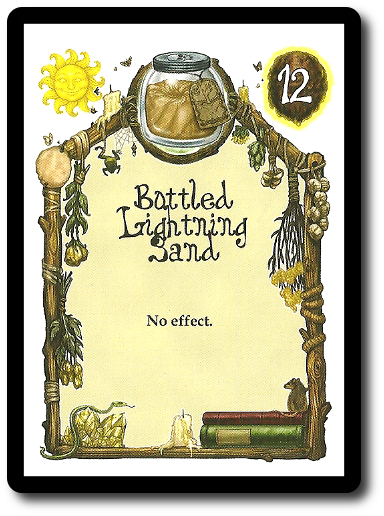
Orange Fairy
The orange “Fairy” Ingredient cards (representing high-end ingredients that provide nothing of real value) are multipliers. They multiply the points provided by other Ingredient cards, but provide no points on their own. They also grant a level of protection from an opponent’s attempt to sabotage the player’s Miracle Pill.
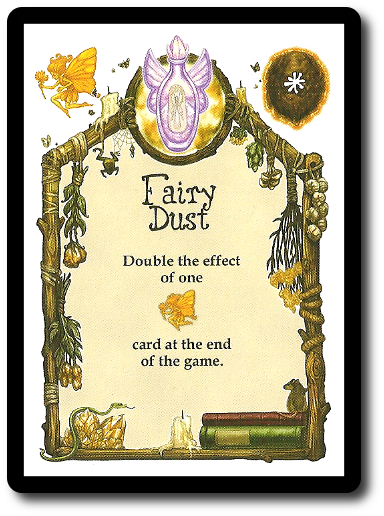
Green Snail
The green “Snail” Ingredient cards (representing slimy, icky things that are healthy for you) stack to increase the potency of the Miracle Pill. The more Snails the player has, the more potent the pill.
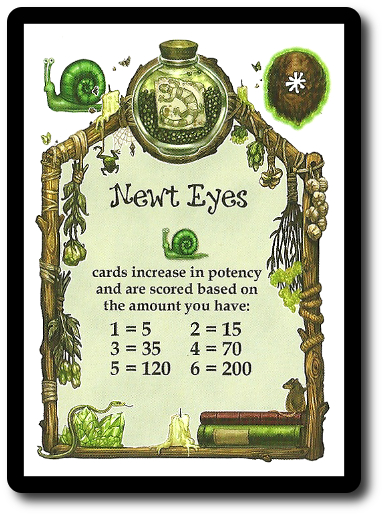
Blue Water
The blue “Water” Ingredient cards (representing various liquids from various places) make the process of creating a Miracle Pill easier. They are an efficient means to an end, allowing a player to improve their overall score by making Potions.
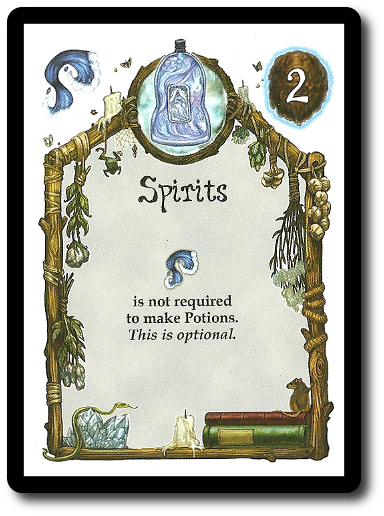
Red Fang
The red “Fang” Ingredient cards (representing poisonous and nasty things) are played against opponents, sabotaging their efforts to create the best Miracle Pill. So potent are these cards that they not only reduce points, but can also remove cards from play.
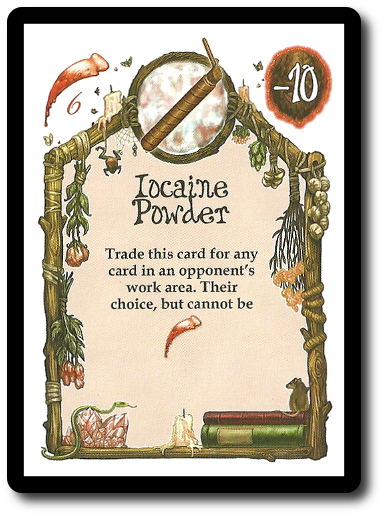
Black Spoon
The black “Spoon” Ingredient card is only revealed during the third and final round of the game. These cards provide special bonuses that can only be claimed at the end of the game.
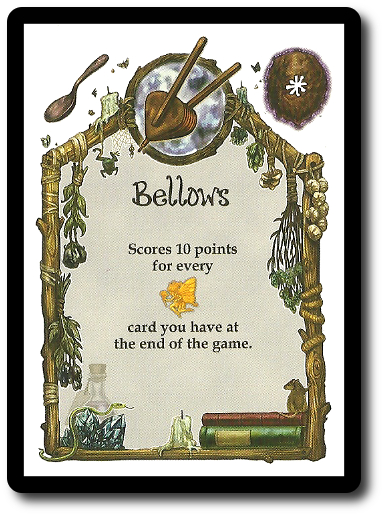
Rainbow “Wild”
The rainbow “Wild” Ingredient cards can be used as any color for Potion making and end of game scoring, but do not provide any special benefit. Think of these as unnecessary fillers that do the job, but don’t deliver much in the way of unique value.
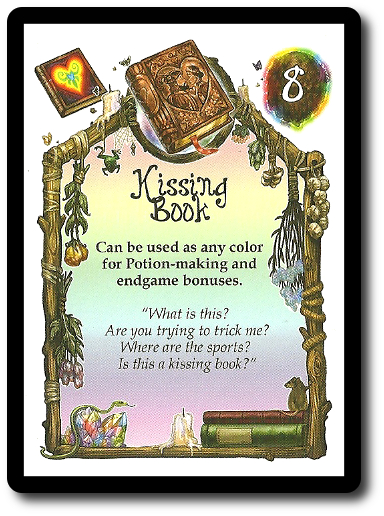
When a player selects a card, they place it in front of them, face-down, and wait for the rest of the players to do the same. When everyone has placed a card, they are simultaneously revealed and then resolved. The player can also leave the card face-down, indicating that the Ingredient card will be a substitute for any other card necessary to create a Potion. After the card is resolved, it remains in front of the player. This space of played cards is referred to as the player’s “Work Area”.
After the Ingredient cards are resolved and placed in the players’ Work Areas, the remaining cards are passed to the opponent on the player’s left. The entire process is then repeated until all players have played 3 cards (completing 3 turns). The fourth card is discarded.
Next Round and More Miracles
Round Two now begins and is played almost the exact same way, except the cards are passed to the right. Round Three again passes the cards to the left. All players are still dealt 4 cards from the current Round deck and only have 3 turns per round to play cards.
During Round Two and Round Three, players can start to make Potions. To create a Potion, a player must sacrifice their collected Ingredient cards. While this might sound like a horrible idea, a Potion card is oftentimes a much more powerful and potent alternative. If the player does not have the necessary Ingredient cards to create a Potion, they can sacrifice a face-down card they played to represent that which they are missing. When the player does create the Potion, it’s placed in their Work Area and any Ingredient cards used to make it are removed from the game.

Have Fun Storming the Castle!
Finally! The Miracle Pill has been created and the Man in Black can be revived! But which one of the players created the best Miracle Pill? It’s time to determine which player is truly on par with Miracle Max.
Scoring is a game in and of itself as the Ingredient cards can be mixed, matched, and moved to score points. However the player goes about it, each Ingredient card can only be scored once. This means that some Ingredient cards that can be used 2 or more different ways can only be scored one time, making the process of determining how best to used them not always easy. But nor is the scoring portion of the game difficult. There are only so many ways and only so many cards to score. A player might find that there are more than 2 ways to score a card, but the choice is obvious. When a player has determined how best to organize their Ingredient cards, they do so in rows and stacks to help make counting points easy.
The only Ingredient cards that must be scored last are the red “Fang” Ingredient cards. These are resolved after the player has determined how many points they earned during the game. The player’s final score will most likely be lowered, but there are ways to protect points and even benefit from the penalties they inflict.
When all the points are determined and no more adjustments are needed, the player with the most points wins the game.
House Rule
Most players, including our Child Geeks, found the limitation of playing 3 cards per round to be a bit annoying. To address this, we dealt the players more cards per round. There is a limit, however, since there are only 24 cards per deck. This makes the game longer (which no one minded), but we made certain to always leave some cards behind to keep the players guessing.
- 2 player game = 11 cards each, 10 played, 2 remaining in the deck
- 3 player game = 7 cards each, 6 played, 3 remaining in the deck
- 4 player game = 5 cards each, 4 played, 4 remaining in the deck
- 5 and 6 player game = deal cards are normal
To learn more about The Princess Bride: Miracle Pill, visit the game’s web page.
Final Word
The Child Geeks biggest issue with the game was deciding if they should keep Fang cards or not. In most cases they did, as they simply could not pass on the opportunity to damage an opponent’s score. Besides, they quickly learned that a Fang card skipped was a Fang card soon played by another. This didn’t cause any real issues, but it was always funny to see the Child Geeks attack others who had very little in the way of points. As one Child Geek put it, “It’s better to play the Fangs now and skip good cards than have good cards hurt by Fangs later.” Possibly, but it always came down to the random draw of the cards. This helped the Child Geeks determine the overall value of selecting the Fang card, but they could not plan on it. Consequently, a Fang card (or any negative card for that matter) was always played within the first or second passing of the cards. The rest of the round was spent on true card selection for their value, both short and long-term. As one Child Geek put it, “The best part of this game is thinking through what you want to do and what you can do. It’s fun!” The Princess Bride: Miracle Pill was approved by the Child Geeks.
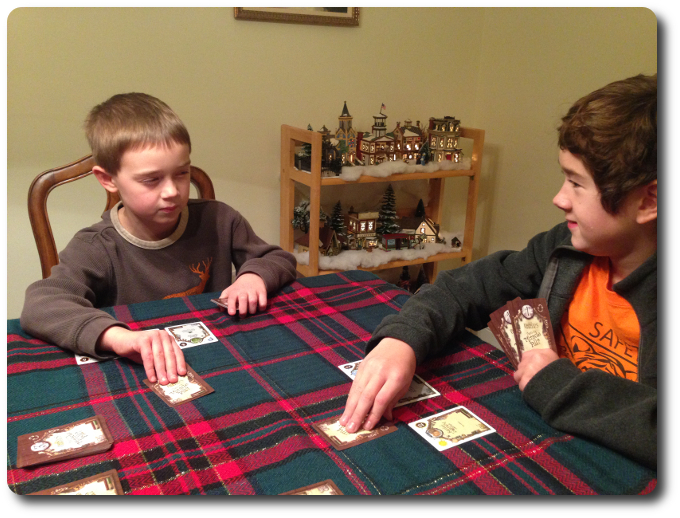
Game play was quick and not a bit of trust was given from the first card to the last
The Parent Geeks found the game to be very random, but enjoyable. According to one Parent Geek, “This reminds me of Sushi Go!, but the choices seem to be a bit more difficult at times since the cards are so random.” Which is to say, the Parent Geeks enjoyed themselves, but were unable to do much other than simply make a choice based on what was provided at the time. The majority of the Parent Geeks didn’t think this was an issue, but a few of the more experienced Parent Geeks didn’t much care for it. One such Parent Geek said, “It feels a little like 7 Wonders, but is missing all the tactical and strategic fun.” Despite the game missing the mark with a few Parent Geeks, it was still enthusiastically received by the majority. As such, the game was approved by the Parent Geeks.
The Gamer Geeks were not impressed, but this was to be expected. This group plays card games like The Princess Bride: Miracle Pill that have a good deal more depth, strategy, and tactical game play. This game was designed to be light and fast, which all the Gamer Geeks agreed it was. As one Gamer Geek put it, “I think this is a great game for the family or for a Gamer Geek to play with a family who is not familiar with a lot of games.” Another Gamer Geek said, “There is a game here, but I don’t think it’s for me. It’s too random and too short to make any meaningful decisions.” Ultimately, what caused the Gamer Geeks to reject The Princess Bride: Miracle Pill was the lack of challenge it provided (from their perspective).
I didn’t find the game to be all that great, but nor did I find it to be a bad game, either. I share the Gamer Geek’s perspective in regard’s to the game’s level of depth. It’s not a deep enough game to keep me interested, but I did find myself thinking through my plays and selection of cards. Which is to say, The Princess Bride: Miracle Pill is not a game you can sleep through. The cards you select now will impact your score later.
The Parent Geek in me really enjoyed the game. The challenge is not terribly great, but the decisions are sometimes difficult to make. Especially when it comes to determining if it’s the right time to create a Potion or to keep forging ahead by collecting certain cards. The most difficult aspect of the game is simply deciding what to do. Cards have both points and effects, making the choice of which card to select sometimes difficult.
The Fang cards are fun to play, but can also be problematic. Since everyone knows what cards you have collected so far, it can be very tempting to slap down a Fang card for your turn instead of working on earning more points for yourself. In a 2-player game, it makes perfect sense, since you are only competing against another person. In a 3 or more person game, playing a Fang card might mean hurting another opponent’s points, but you also hurt your own by not collecting anything on the same turn. If you not only play a Fang card on another, but also have a Fang card played on you, you have lost some serious ground.
Overall, I’m pleased with the game. It lacks much in the way that is new and has very little to do with the movie from which it’s exceedingly loosely based, but none of that detracted from the fun it provided. I would recommend this card game for families and for Parent Geeks who like playing card games with their peers. The Gamer Geeks might find some enjoyment, but only when playing with others who are not gaming elitists.
This game was given to Father Geek as a review copy. Father Geek was not paid, bribed, wined, dined, or threatened in vain hopes of influencing this review. Such is the statuesque and legendary integrity of Father Geek.



